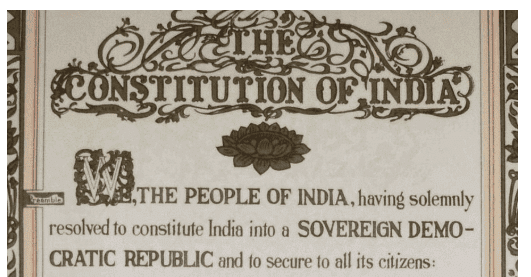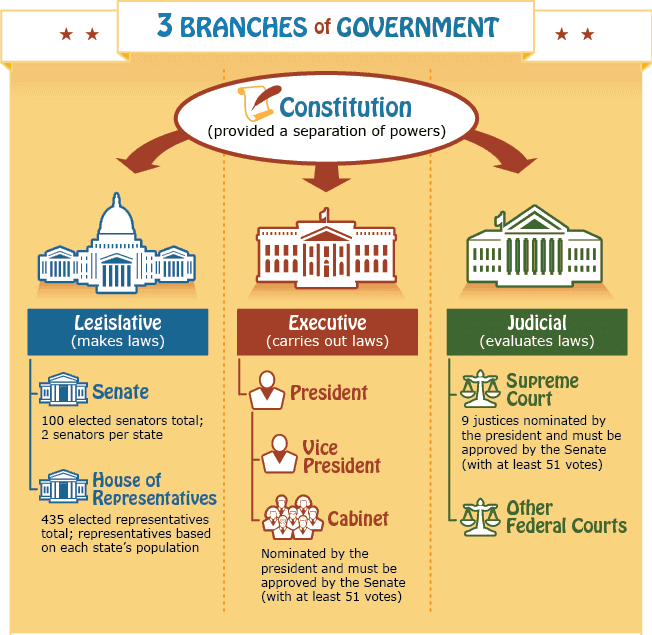Important Questions - The Parliamentary System: Legislature and Executive | Social Science Class 8 - New NCERT PDF Download
Q1. What is India's parliamentary system, and how is it structured?
Ans: India’s parliamentary system is a democratic way of governing where the Parliament makes laws and works with the people’s approval. It includes:
- Lok Sabha (House of the People): Elected directly by citizens through voting. It has up to 550 members, chosen based on state population, and is led by a Speaker.
- Rajya Sabha (Council of States): Represents states, with members elected by state assemblies. The Vice President is its chairperson.
- President: Part of Parliament, signs bills into laws, and calls sessions. This bicameral (two-house) system ensures people and states have a voice in making laws.
Q2. What role does the Constitution play in India’s parliamentary democracy?
Ans: Constitution refers to a set of fundamental principles or laws that govern a country or organisation. It defines:
- The structure of the government.
- The powers of various branches.
- The rights and duties of citizens.

The Indian Constitution is a set of rules that guides how the country is run. It:
- Allows all adults to vote (universal adult franchise) to elect Lok Sabha members.
- Divides power among the Legislature (makes laws), Executive (carries out laws), and Judiciary (checks laws).
- Supports federalism by sharing power between the central and state governments.
- Protects Fundamental Rights, like the right to education for kids aged 6–14 (Article 21A). It ensures fair governance and protects people’s rights.
Q3. How does the Indian Parliament reflect federalism?
Ans: Federalism means sharing power between the central and state governments. The Parliament shows this by:
Having a Rajya Sabha, which represents states, with members chosen by state assemblies based on population.
Dividing lawmaking powers into:
- Union List (e.g., defense, for the central government).
- State List (e.g., agriculture, for states).
- Concurrent List (e.g., education, for both, but Union laws come first). This ensures states have a say in national laws, balancing unity and diversity.
Q4. Explain the functions of organs of government.
Ans: According to the constitution, there are three organs of the state:
- Legislature: This includes our elected representatives who create laws and procedures.
- Executive: A smaller group responsible for implementing laws and managing government operations.
- Judiciary: This consists of the court system that interprets laws and resolves disputes.

Q5. What is the system of checks and balances in India’s government?
Ans: Checks and balances stop any part of the government from becoming too powerful:
- Legislature (Parliament): Makes laws and checks the Executive through Question Hour, where MPs ask ministers about their work.
- Executive (Prime Minister and Ministers): Implements laws and answers to the Lok Sabha. Most bills start with them.
- Judiciary (Courts): Checks if laws and actions follow the Constitution and protects people’s rights. This system keeps all parts accountable and fair.
Q6. Describe in detail the various features of the Indian constitution.
Ans:
(a) Federalism
- India has multiple levels of government, each with its own authority derived from the constitution.
- Both the central and state governments create laws and policies that govern all citizens.
(b) Parliamentary Form of Government
- The government is made up of representatives elected by the people.
- The constitution guarantees universal adult suffrage, allowing all citizens to vote.
- Any citizen can contest elections, regardless of social background.
(c) Separation of Powers
- The constitution establishes three branches of government:
- Legislature: Elected representatives.
- Executive: A smaller group responsible for implementing laws.
- Judiciary: The system of courts that interprets laws.
(d) Fundamental Rights
- Considered the ‘conscience’ of the constitution, these rights protect citizens from misuse of state power.
- They were established to safeguard against arbitrary actions of the government.
(e) Secularism
- In a secular state, the government does not endorse any specific religion.
Q7. What are the challenges to the effective functioning of India’s legislatures?
Ans: India’s Parliament and State Assemblies face issues that affect their work:
- Disruptions: Sessions get interrupted, reducing productivity (e.g., Rajya Sabha productivity fell to 65% after 2014).
- Absenteeism: Some members skip sessions, delaying lawmaking.
- Poor Debates: Debates can be angry or off-topic, lowering quality.
- Delayed Bills: Disruptions cause bills to take years to pass.
- Criminal Cases: Some MPs have criminal cases, raising trust issues. More citizen involvement, like young voters asking questions, can help improve this.
Q8. What inspired India’s parliamentary system according to the Constitution makers?
Ans: The Constitution makers designed India’s parliamentary system using:
- British System: Inspired the bicameral Parliament and procedures like Question Hour.
- Colonial Experience: Leaders learned from limited roles in British governance.
- Ancient Republics (Mahajanapadas): Early Indian democratic systems influenced the idea of representation.
- Village Panchayats: Local decision-making by elders inspired participation.
- Federal Needs: A bicameral system with Rajya Sabha was chosen to represent states and meet India’s diverse challenges.
Q9. What are the constitutional functions of the Parliament?
Ans: The Parliament has key constitutional roles:
- Enabling Democracy: Allows all adults to vote for Lok Sabha members.
- Separation of Powers: Works with the Executive and Judiciary to balance power.
- Federalism: Represents states through the Rajya Sabha.
- Protecting Rights: Makes laws like the RTE Act to ensure rights, such as education for kids aged 6–14.
- Elections: Elects the President and Vice President.
- Amending Constitution: Updates the Constitution, like adding Article 21A for education. These roles keep India’s democracy strong.
Q10. What symbolic item is placed near the Speaker’s chair in the new Lok Sabha, and what does it represent?
Ans: The Sengol, a gold-plated silver sceptre from the Chola period, is placed near the Speaker’s chair in the new Lok Sabha. It:
- Was given to Pt. Jawaharlal Nehru on 14 August 1947, marking India’s independence.
- Represents righteous and just rule, reminding MPs to govern fairly.
- Has Nandi (a bull) on top, symbolizing justice. It connects India’s ancient traditions with its modern democracy.
|
31 videos|128 docs|7 tests
|
FAQs on Important Questions - The Parliamentary System: Legislature and Executive - Social Science Class 8 - New NCERT
| 1. What is the difference between the legislature and the executive in a parliamentary system? |  |
| 2. How does the Prime Minister get selected in a parliamentary system? |  |
| 3. What role does the opposition play in the legislative process? |  |
| 4. Can the Prime Minister be removed from office? If so, how? |  |
| 5. What is the significance of the "collective responsibility" of the cabinet in a parliamentary system? |  |





















